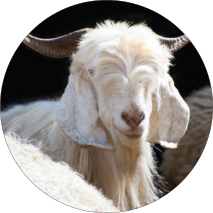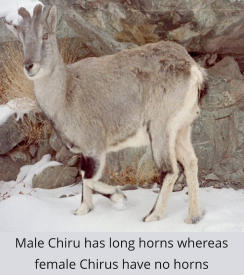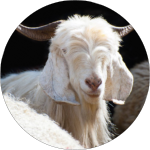Pashmina - Shahtoosh Shawls
Shawls - India’s Specialty
Pashmina Shawls are one of the items that is on the shopping list of many foreign tourist visiting India.
Indian Pashmina is in demand all over the world and makes an excellent gift. As India is considered the place where Pashmina wool was first made. Many tourists end up buying Pashmina shawls while vacationing in India. A large number of fake Pashmina shawls are also sold in India and even the Internet. A little bit of information and alertness on the part of purchasers can save them money when making purchases of such shawls.How are Pashmina shawls made ?
Pashmina shawls are popular not only in India but also abroad. The Internet today is full of dealers trying to sell Pashmina shawls. Tourists are often approached while in India to purchase Pashmina shawls as they walk in tourist areas and shopping markets and in such circumstances are enticed to shawls that are not Pashmina. How does one differentiate between fake and genuine Pashmina shawls? Many do not even know what Pashmina means, so let me try and explain a few things that may help. What is genuine Pashmina? Pashmina shawls are popular not only in India but also abroad. The Internet today is full of dealers trying to sell Pashmina shawls. Tourists are often approached while in India to purchase Pashmina shawls as they walk in tourist areas and shopping markets and in such circumstances are enticed to shawls that are not Pashmina. How does one differentiate between fake and genuine Pashmina shawls? Many do not even know what Pashmina means, so let me try and explain a few things that may help.What is genuine Pashmina?
The word Pashmina is derived from the Persian word for wool. Pashmina weaving began some 400 years ago in the Kashmir Valley and was earlier considered the choice fabric of the royal families and the maharajahs in India.Where does Pashmina wool come from? - Pure Pashmina
Pashmina wool comes from the Changra goats. Changthang is a high altitude plateau with gentle slopes in Ladakh India. Changthang stretches approximately 1600 kilometers into Tibet. It is in Changthang that the Changra goats are found. These goats are usually raised by the local inhabitants not for their meat, but rather for their milk and (Pashmina) wool. Pashmina wool is the softer hair located at the root of the longer hair. Each goat produces less than 100 grams of wool fiber. A fine Pashmina would require the annual growth of at least three goats to weave one shawl as only a small part at the root of each hair is soft enough to be true Pashmina. Pure Pashmina is said to be almost weightless. Hence when making shawls some quantity of silk is usually added to give the fabric some body. The quality of the Pashmina must be determined by actually how much silk has been added. So the more silk a Pashmina shawl has the less real Pashmina in it. Remember, more silk in a shawl means less Pashmina wool in it. All phases of producing Pashmina like removing the goats hair, sorting, spinning, weaving, dyeing are done by hand and the scarce availability of pure Pashmina make the cost of pure Pashmina shawls quite expensive. Naturally if there is a limited supply of the real thing and prices are high this provides the setting for imitation Pashmina to enter the market in a big way. As pure Pashmina yarn is very expensive some manufacturers blend their shawls with silk thread, rabbit fur or with wool. Pure Pashmina is unmistakable for its softness, negligible weight and warmth.Are Changra goats slaughtered for their Pashmina?
The answer to this is a definite NO. Despite some rumors that these goats are slaughtered, nothing could be further from the truth. If farmers were to slaughter these goats they would lose their source of income. These goats also provide them with milk. People who claim that the Changra goats are killed for their Pashmina probably confuse these Changra goats with the Tibet’s Chiru antelope. The Chiru is not used for Pashmina shawls but for Shahtoosh shawls.Shahtoosh shawls alert for tourists.
Associated with India is also another name in shawls. ‘The Shahtoosh Shawl’ Indians usually brag about the pure Shahtoosh shawls not only for its superb warmth qualities and light weight but the fact that the entire shawl is so light that one can pass it through a ring that fits on a persons finger. There is no debate on the excellent qualities of the Shahtoosh shawls. These shawls are made from the hair derived from a Tibetan antelope called a Chiru. The Chiru is found in areas of Tibet that have extreme cold weather, nature has provided this antelope with two layered fur to survive. The outer fur coat of the Chiru is coarse. The hair under the first layer that touches the skin of the Chiru is soft. The short hair that is closest to the Chiru’s inner fur was used to make Shahtoosh shawls. So the Chiiru was killed, the outer layer of coarse hair removed to get to the second inner layer of fine hair that was used to make shawls.Shahtoosh shawls banned - Sale/Purchase of Shahtoosh shawls in India is illegal
The government of India banned the sale of Shahtoosh in India around 1977. Governments all over the world have I believe banned the import of Shahtoosh. There are stiff penalties in India for buying or selling this product. If approached to purchase such items do not hesitate to notify the police. Pashmina shawls on the other hand have no restrictions and can be bought all over India.



Travel India Info
Complete Touring Guide for exploring India
We are not associated with any tour or travel business


© Copyright TravelIndiaInfo.net - All rights reserved
Pashmina - Shahtoosh Shawls
Shawls - India’s Specialty
Pashmina Shawls are one of the
items that is on the shopping list
of many foreign tourist visiting
India.
Indian Pashmina is in demand all over the world and makes an excellent gift. As India is considered the place where Pashmina wool was first made. Many tourists end up buying Pashmina shawls while vacationing in India. A large number of fake Pashmina shawls are also sold in India and even the Internet. A little bit of information and alertness on the part of purchasers can save them money when making purchases of such shawls. How are Pashmina shawls made ? Pashmina shawls are popular not only in India but also abroad. The Internet today is full of dealers trying to sell Pashmina shawls. Tourists are often approached while in India to purchase Pashmina shawls as they walk in tourist areas and shopping markets and in such circumstances are enticed to shawls that are not Pashmina. How does one differentiate between fake and genuine Pashmina shawls? Many do not even know what Pashmina means, so let me try and explain a few things that may help. What is genuine Pashmina? Pashmina shawls are popular not only in India but also abroad. The Internet today is full of dealers trying to sell Pashmina shawls. Tourists are often approached while in India to purchase Pashmina shawls as they walk in tourist areas and shopping markets and in such circumstances are enticed to shawls that are not Pashmina. How does one differentiate between fake and genuine Pashmina shawls? Many do not even know what Pashmina means, so let me try and explain a few things that may help.What is genuine
Pashmina?
The word Pashmina is derived from the Persian word for wool. Pashmina weaving began some 400 years ago in the Kashmir Valley and was earlier considered the choice fabric of the royal families and the maharajahs in India.Where does Pashmina wool come from? -
Pure Pashmina
Pashmina wool comes from the Changra goats. Changthang is a high altitude plateau with gentle slopes in Ladakh India. Changthang stretches approximately 1600 kilometers into Tibet. It is in Changthang that the Changra goats are found. These goats are usually raised by the local inhabitants not for their meat, but rather for their milk and (Pashmina) wool. Pashmina wool is the softer hair located at the root of the longer hair. Each goat produces less than 100 grams of wool fiber. A fine Pashmina would require the annual growth of at least three goats to weave one shawl as only a small part at the root of each hair is soft enough to be true Pashmina. Pure Pashmina is said to be almost weightless. Hence when making shawls some quantity of silk is usually added to give the fabric some body. The quality of the Pashmina must be determined by actually how much silk has been added. So the more silk a Pashmina shawl has the less real Pashmina in it. Remember, more silk in a shawl means less Pashmina wool in it. All phases of producing Pashmina like removing the goats hair, sorting, spinning, weaving, dyeing are done by hand and the scarce availability of pure Pashmina make the cost of pure Pashmina shawls quite expensive. Naturally if there is a limited supply of the real thing and prices are high this provides the setting for imitation Pashmina to enter the market in a big way. As pure Pashmina yarn is very expensive some manufacturers blend their shawls with silk thread, rabbit fur or with wool. Pure Pashmina is unmistakable for its softness, negligible weight and warmth.Are Changra goats slaughtered for their
Pashmina?
The answer to this is a definite NO. Despite some rumors that these goats are slaughtered, nothing could be further from the truth. If farmers were to slaughter these goats they would lose their source of income. These goats also provide them with milk. People who claim that the Changra goats are killed for their Pashmina probably confuse these Changra goats with the Tibet’s Chiru antelope. The Chiru is not used for Pashmina shawls but for Shahtoosh shawls.Shahtoosh shawls alert for tourists.
Associated with India is also another name in shawls. ‘The Shahtoosh Shawl’ Indians usually brag about the pure Shahtoosh shawls not only for its superb warmth qualities and light weight but the fact that the entire shawl is so light that one can pass it through a ring that fits on a persons finger. There is no debate on the excellent qualities of the Shahtoosh shawls. These shawls are made from the hair derived from a Tibetan antelope called a Chiru. The Chiru is found in areas of Tibet that have extreme cold weather, nature has provided this antelope with two layered fur to survive. The outer fur coat of the Chiru is coarse. The hair under the first layer that touches the skin of the Chiru is soft. The short hair that is closest to the Chiru’s inner fur was used to make Shahtoosh shawls. So the Chiiru was killed, the outer layer of coarse hair removed to get to the second inner layer of fine hair that was used to make shawls.Shahtoosh shawls banned -
Sale/Purchase of Shahtoosh shawls in
India is illegal
The government of India banned the sale of Shahtoosh in India around 1977. Governments all over the world have I believe banned the import of Shahtoosh. There are stiff penalties in India for buying or selling this product. If approached to purchase such items do not hesitate to notify the police. Pashmina shawls on the other hand have no restrictions and can be bought all over India.




© Copyright TravelIndiaInfo.net - All rights reserved
























